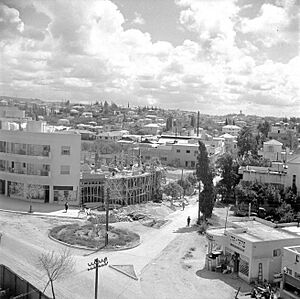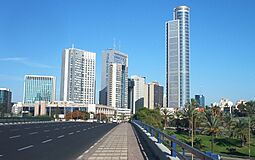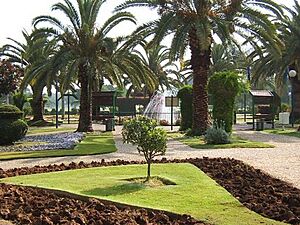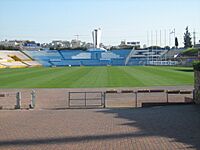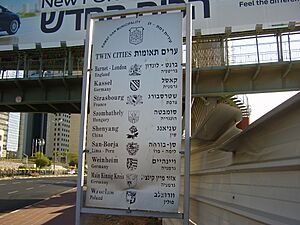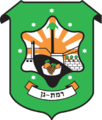Ramat Gan facts for kids
Quick facts for kids
Ramat Gan
רָמַת גַּן
רָמַת־גַּן |
|||
|---|---|---|---|
|
City (from 1950)
|
|||
| Hebrew transcription(s) | |||
| • Also spelled | Ramat-Gan | ||
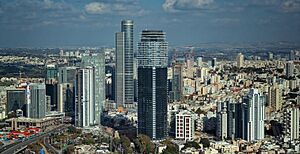
View of the Diamond Exchange District from the Azrieli Center
|
|||
|
|||
| Country | |||
| District | |||
| Founded | 1921 | ||
| Area | |||
| • Total | 12,214 dunams (12.214 km2 or 4.716 sq mi) | ||
| Population | |||
| • Total | 172,486 | ||
| Name meaning | Garden Heights | ||
| Website | www.ramat-gan.muni.il | ||
Ramat Gan (Hebrew: רָמַת גַּן or רָמַת־גַּן) is a city in Israel. It is located east of Tel Aviv and is part of the larger Tel Aviv area. Ramat Gan is famous for its Diamond Exchange District, which is one of the biggest diamond trading centers in the world. It also has Sheba Medical Center, the largest hospital in Israel, and many companies that work with high-tech industries.
Ramat Gan started in 1921 as a moshava. This was a special type of farming community. By 2022, the city had a population of over 172,000 people.
Contents
- History of Ramat Gan: From Farms to City Life
- Geography and Climate: Exploring Ramat Gan's Surroundings
- Demographics: Who Lives in Ramat Gan?
- Education: Learning in Ramat Gan
- Religions: Places of Worship
- Healthcare: Hospitals and Clinics
- Archaeology: Discovering the Past
- Culture: Arts, Entertainment, and Nature
- Sports: Home of the Maccabiah Games
- Notable People: Famous Faces from Ramat Gan
- Twin Towns: Ramat Gan's Sister Cities Around the World
- Images for kids
- See also
History of Ramat Gan: From Farms to City Life
Ramat Gan was created in 1921 by a group called Ir Ganim. It was planned as a smaller town next to Tel Aviv. The first pieces of land were bought between 1914 and 1918. At first, it was a farming village where people grew crops like wheat and watermelons.
In 1923, the settlement's name was changed to Ramat Gan. This name means "Garden Height." It continued as a farming village until 1933. However, it became an official local council in 1926. At that time, only 450 people lived there.
Over the years, Ramat Gan changed from a farming area to a place for business and factories. By 1946, its population had grown to 12,000 people. In 1950, Ramat Gan officially became a city. Many Iraqi Jews moved to Ramat Gan during a time called Operation Ezra and Nehemiah. Because so many Iraqi immigrants settled there, people sometimes called it "Little Baghdad." By 1955, the city had 55,000 residents.
The first mayor of Ramat Gan was Avraham Krinitzi. He was mayor for a very long time, 43 years! In 1961, Ramat Gan grew bigger to include important places like the Sheba Medical Center and Bar Ilan University. In 1968, the world's largest diamond exchange opened in Ramat Gan.
Geography and Climate: Exploring Ramat Gan's Surroundings
Ramat Gan is part of the Gush Dan area, which is a large group of cities around Tel Aviv. It is located east of Tel Aviv. The Yarkon River is to its north, and the city of Bnei Brak is to its east. Giv'atayim is to the southwest.
Ramat Gan gets about 560 millimeters (22 inches) of rain each year. It is about 80 meters (262 feet) above sea level. The city is built on hills made of limestone.
Ramat Gan has many parks. One of the biggest is The National Park, which covers a huge area. About 25% of Ramat Gan is covered by public parks.
Neighborhoods of Ramat Gan
Ramat Gan has many different neighborhoods. Some of these include Shchunat Hageffen, City Center, Nachalat Ganim, Kiryat Krinitzi, Ramat Shikma, Ramat Yitzhak, Shchunat Rishonim, Tel Yehuda, Givat Geula, Neve Yehoshua, Kiryat Borochov, Merom Naveh, Ramat Amidar, Ramat Chen, Shikun Vatikim, Shchunat Hillel, Elite, Diamond Exchange District, and Tel Binyamin.
Demographics: Who Lives in Ramat Gan?
| City of Ramat Gan Population by year |
|
| 1948 | 17,200 |
| 1955 | 58,500 |
| 1961 | 90,800 |
| 1972 | 118,000 |
| 1983 | 117,100 |
| 1995 | 128,700 |
| 2005 | 128,400 |
| 2010 | 146,200 |
| 2013 | 149,600 |
In 1931, Ramat Gan had 975 people living in 253 houses. By 2006, the city had about 129,700 residents. The population was growing by about 1% each year. Most of this growth was from new births. Ramat Gan is a very crowded city, with about 9,822 people per square kilometer.
Many people living in Ramat Gan come from different parts of the world. In 2006, about 42,900 people were from Europe and America. About 10,200 were from Africa, and 29,200 were from Asia. Also, 40,600 people were born in Israel.
Economy and Jobs in Ramat Gan
Ramat Gan's economy is largely focused on the Diamond Exchange District. This area has many tall buildings, called skyscrapers. One of them is the Moshe Aviv Tower, which is Israel's second tallest building. The Israel Diamond Exchange is a global leader in diamond trading. Many high-tech companies, like Check Point Software Technologies, are also located here.
Several countries have their embassies in Ramat Gan, including Ghana, Kenya, and Norway. The British Council also has an office here. The Histadrut, a large trade union, has its main office in the city.
Ramat Gan is also important for factories and manufacturing. It has plants that can fruits and vegetables, textile mills, and places that make metal products, electrical items, and furniture. A new tall building called the Elite Tower is being built. It will be even taller than the Moshe Aviv Tower. The lower floors of this new tower will have a chocolate museum, as a tribute to the old Elite Candy factory that used to be there.
Education: Learning in Ramat Gan
Ramat Gan is home to Bar-Ilan University, which is Israel's second largest university with 24,000 students. The city also has other important colleges. These include the Shenkar College of Engineering and Design, Ramat Gan College, the College of Law and Business, and Beit Zvi, which is a college for acting.
Religions: Places of Worship
Ramat Gan has many places of worship. There are 112 synagogues, which are Jewish places of worship. It also has two yeshivot, which are schools for Jewish studies, and a Kabbalah Center.
Besides Jewish places of worship, Ramat Gan also has a Buddhist temple and a Scientology center.
Healthcare: Hospitals and Clinics
The Sheba Medical Center is located in Ramat Gan and is Israel's largest hospital. It includes special centers like the Safra Children's Hospital. The city also has 32 medical centers run by health authorities. The city government operates 10 clinics for children. The nearby city of Bnei Brak also has a hospital called Mayanei Hayeshua Medical Center.
Archaeology: Discovering the Past
Northwest of Ramat Gan is an old archaeological site called Tel Gerisa. This site shows signs of human life from very old times, especially during the Middle and Late Bronze Ages.
Culture: Arts, Entertainment, and Nature
Ramat Gan has many places for culture and entertainment. These include the Ramat Gan Theater and the Diamond Theater. The Beit Zvi School of Performing Arts is also in Ramat Gan. For movies, there are two cinema complexes: the Lev-Elram Cinema and the "Yes Planet" megaplex.
Ramat Gan also has a famous safari park. This park covers 250 acres and has both a drive-through area, like an African safari, and a modern outdoor zoo.
Museums in Ramat Gan
Ramat Gan has several interesting museums:
- Beit Avraham Krinitzi: This was the home of the first mayor and is now a museum about Ramat Gan's history.
- Man and the Living World Museum: This is a natural history museum where you can learn about nature.
- Maccabi Museum: This museum tells the story of Jewish sports since 1898.
- Ramat Gan Safari: This is a huge zoo with 1,600 animals, making it the largest animal collection in the Middle East.
- Museum of Israeli Art: This museum shows Israeli art and has sculpture galleries.
- Museum of Russian Art: This museum displays art from Russia.
- Museum of Jewish Art: This museum focuses on Jewish art.
- Yehiel Nahari Museum of Far Eastern Art: This museum features art from East Asia.
Sports: Home of the Maccabiah Games
The Maccabiah Games, a big international Jewish sports event, are held in Ramat Gan every four years. The Ramat Gan Stadium was Israel's main football stadium until 2014. It can hold over 41,000 people.
Ramat Gan has two main football clubs: Hakoah Amidar Ramat Gan and Hapoel Ramat Gan. Both teams play at the Winter Stadium and have won championships in the past. In basketball, the team Ironi Ramat Gan plays in the top league, Ligat HaAl.
Notable People: Famous Faces from Ramat Gan

Many famous people have come from Ramat Gan. Here are a few:
- Blessing Afrifah (born 2003), an Olympic sprinter.
- Avi Arad (born 1948), who helped create Marvel Studios.
- Lior Ashkenazi (born 1968), a well-known actor.
- Aviv Geffen (born 1973), a popular musician.
- Etgar Keret (born 1967), a famous author.
- Inbar Lavi (born 1986), an actress.
- Kobi Marimi (born 1991), a singer who represented Israel in the Eurovision Song Contest 2019.
- Ilan Ramon (1954–2003), the first Israeli astronaut. He sadly died in the Space Shuttle Columbia disaster.
- Tom Reuveny (born 2000), an Olympic champion in windsurfing.
- Silvan Shalom (born 1958), a politician.
Twin Towns: Ramat Gan's Sister Cities Around the World
Ramat Gan has "twin towns" or "sister cities" in many countries. These are cities that have special friendly relationships with each other.
 Barnet, United Kingdom (since 1976)
Barnet, United Kingdom (since 1976) Kassel, Germany (since 1990)
Kassel, Germany (since 1990) Main-Kinzig District, Germany (since 2000)
Main-Kinzig District, Germany (since 2000) Penza, Russia (since 2007)
Penza, Russia (since 2007) Phoenix, United States (since 2005)
Phoenix, United States (since 2005) Qingdao, China (since 2012)
Qingdao, China (since 2012) Rio de Janeiro, Brazil (since 2011)
Rio de Janeiro, Brazil (since 2011) San Borja, Peru (since 2014)
San Borja, Peru (since 2014) Shenyang, China (since 1993)
Shenyang, China (since 1993) Strasbourg, France (since 1991)
Strasbourg, France (since 1991) Szombathely, Hungary (since 1995)
Szombathely, Hungary (since 1995) Taoyuan, Taiwan (since 2016)
Taoyuan, Taiwan (since 2016) Weinheim, Germany (since 1999)
Weinheim, Germany (since 1999) Wrocław, Poland (since 1997)
Wrocław, Poland (since 1997)
Images for kids
See also
 In Spanish: Ramat Gan para niños
In Spanish: Ramat Gan para niños







